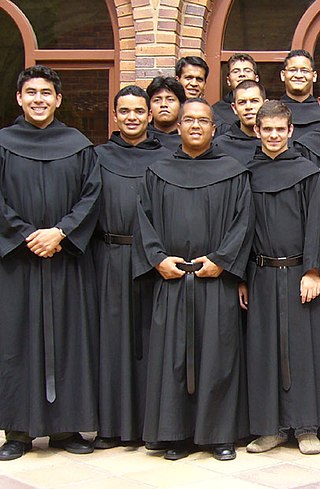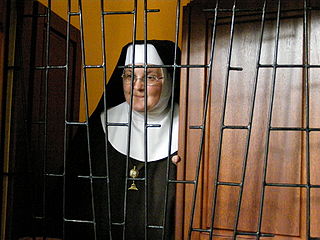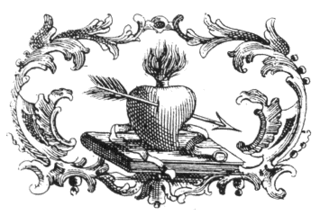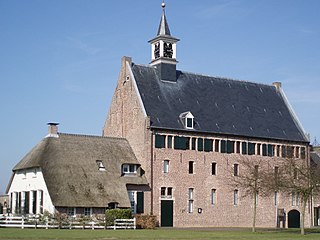Related Research Articles

The Order of the Brothers of the Blessed Virgin Mary of Mount Carmel, known as the Carmelites or sometimes by synecdoche known simply as Carmel, is a mendicant order in the Catholic Church for both men and women. Historical records about its origin remain uncertain; it was probably founded in the 12th century on Mount Carmel in what is now Israel.

A convent is an enclosed community of monks, nuns, friars or religious sisters. Alternatively, convent means the building used by the community.
A religious order is a subgroup within a larger confessional community with a distinctive high-religiosity lifestyle and clear membership. Religious orders often trace their lineage from revered teachers, venerate their founders, and have a document describing their lifestyle called a rule of life. Such orders exist in many of the world's religions.

Augustinians are members of several religious orders that follow the Rule of Saint Augustine, written in about 400 AD by Augustine of Hippo. There are two distinct types of Augustinians in Catholic religious orders dating back to the 12th–13th centuries:

A friar is a member of one of the mendicant orders in the Roman Catholic Church. There are also friars outside of the Roman Catholic Church, such as within the Anglican Communion. The term, first used in the 12th or 13th century, distinguishes the mendicants' itinerant apostolic character, exercised broadly under the jurisdiction of a superior general, from the older monastic orders' allegiance to a single monastery formalized by their vow of stability. A friar may be in holy orders or be a non-ordained brother. The most significant orders of friars are the Dominicans, Franciscans, Augustinians, and Carmelites.
The Brethren of the Common Life was a Roman Catholic pietist religious community founded in the Netherlands in the 14th century by Gerard Groote, formerly a successful and worldly educator who had had a religious experience and preached a life of simple devotion to Jesus Christ. They believed that Christianity should be practiced not only in formal religious settings, but also in everyday life, and they sought to promote a practical spirituality that emphasized personal piety and devotion.

In the Catholic Church, a religious order is a community of consecrated life with members that profess solemn vows. They are classed as a type of religious institute.

Mendicant orders are, primarily, certain Catholic religious orders that have vowed for their male members a lifestyle of poverty, traveling, and living in urban areas for purposes of preaching, evangelization, and ministry, especially to the poor. At their foundation these orders rejected the previously established monastic model, which prescribed living in one stable, isolated community where members worked at a trade and owned property in common, including land, buildings and other wealth. By contrast, the mendicants avoided owning property at all, did not work at a trade, and embraced a poor, often itinerant lifestyle. They depended for their survival on the goodwill of the people to whom they preached. The members of these orders are not called monks but friars.
The Canons Regular of St. Augustine are Catholic priests who live in community under a rule and are generally organised into religious orders, differing from both secular canons and other forms of religious life, such as clerics regular, designated by a partly similar terminology. As religious communities, they have laybrothers as part of the community.

The Order of Friars Minor Conventual is a male religious fraternity in the Catholic Church and a branch of the Franciscan Order. Conventual Franciscan Friars are identified by the affix O.F.M. Conv. after their names. They are also known as Conventual Franciscans or Minorites.
The Cluniac Reforms were a series of changes within medieval monasticism in the Western Church focused on restoring the traditional monastic life, encouraging art, and caring for the poor. The movement began within the Benedictine order at Cluny Abbey, founded in 910 by William I, Duke of Aquitaine (875–918). The reforms were largely carried out by Saint Odo and spread throughout France, into England, and through much of Italy, northern Portugal and Spain.
Christianity in medieval Scotland includes all aspects of Christianity in the modern borders of Scotland in the Middle Ages. Christianity was probably introduced to what is now Lowland Scotland by Roman soldiers stationed in the north of the province of Britannia. After the collapse of Roman authority in the fifth century, Christianity is presumed to have survived among the British enclaves in the south of what is now Scotland, but retreated as the pagan Anglo-Saxons advanced. Scotland was largely converted by Irish missions associated with figures such as St Columba, from the fifth to the seventh centuries. These missions founded monastic institutions and collegiate churches that served large areas. Scholars have identified a distinctive form of Celtic Christianity, in which abbots were more significant than bishops, attitudes to clerical celibacy were more relaxed and there were significant differences in practice with Roman Christianity, particularly the form of tonsure and the method of calculating Easter, although most of these issues had been resolved by the mid-seventh century. After the reconversion of Scandinavian Scotland in the tenth century, Christianity under papal authority was the dominant religion of the kingdom.

The Order of Discalced Augustinians is a mendicant order that branched off from the Order of Saint Augustine as a reform movement.

Enclosed religious orders are religious orders whose members strictly separate themselves from the affairs of the external world. The term cloistered is synonymous with enclosed. In the Catholic Church, enclosure is regulated by the code of canon law, either the Latin code or the Oriental code, and also by the constitutions of the specific order. It is practised with a variety of customs according to the nature and charism of the community in question. This separation may involve physical barriers such as walls and grilles, with entry restricted for other people and certain areas exclusively permitted to the members of the convent. Outsiders may only temporarily enter this area under certain conditions. The intended purpose for such enclosure is to prevent distraction from prayer and the religious life and to keep an atmosphere of silence.
Independent Augustinian communities are Roman Catholic religious communities that follow the Augustinian Rule, but are not under the jurisdiction of the Prior General of the Augustinian hermits in Rome.

The Order of Saint Augustine, abbreviated OSA, is a mendicant religious order of the Catholic Church. It was founded in 1244 by bringing together several eremitical groups in the Tuscany region who were following the Rule of Saint Augustine, written by Saint Augustine of Hippo in the fifth century.

Colette of Corbie, PCC was a French abbess and the foundress of the Colettine Poor Clares, a reform branch of the Order of Saint Clare, better known as the Poor Clares. She is honored as a saint in the Catholic Church. Due to a number of miraculous events claimed during her life, she is venerated as a patron saint of women seeking to conceive, expectant mothers, and sick children.

The Congregation of Windesheim is a congregation of Augustinian canons regular. It takes its name from its most important monastery, which was located at Windesheim, about four miles south of Zwolle on the IJssel, in the Netherlands.

The English Benedictine Reform or Monastic Reform of the English church in the late tenth century was a religious and intellectual movement in the later Anglo-Saxon period. In the mid-tenth century almost all monasteries were staffed by secular clergy, who were often married. The reformers sought to replace them with celibate contemplative monks following the Rule of Saint Benedict. The movement was inspired by Continental monastic reforms, and the leading figures were Dunstan, Archbishop of Canterbury, Æthelwold, Bishop of Winchester, and Oswald, Archbishop of York.

Pietro Barozzi was an Italian Catholic and humanist bishop.
References
- ↑ "Observant" is often capitalized or expanded into "observantine" (see Oakley 1979 , p. 231). Roest 2009 , p. 446, refers to the movement collectively as "the Observance".
- ↑ Mixson 2015 , p. 1: "a broad and sustained fifteenth-century effort to reform institutional religious life";
Minnich 2005: "a reform movement within almost all of the monastic and mendicant male and many female religious orders of Latin Christendom". - ↑ Mixson 2015 , p. 1: "fifteenth-century";
Minnich 2005: "from the mid-fourteenth century until the Council of Trent (1545–1563)";
Roest 2009 , p. 446: "(c. 1370–1500)". - ↑ Minnich 2005: "for a return to the spirit of each order's founder and a strict observance of the primitive rule";
Roest 2009 , p. 446: "a movement to return to the rules and the lifestyle of their pristine beginnings". - ↑ Roest 2009 , p. 446; Oakley 1979 , p. 252.
- ↑ Oakley 1979, p. 232.
- ↑ Mixson 2015 , p. 3; Minnich 2005.
- ↑ Roest 2009, p. 446.
- ↑ Minnich 2005.
- ↑ Mixson 2015 , p. 1; Oakley 1979 , p. 233.